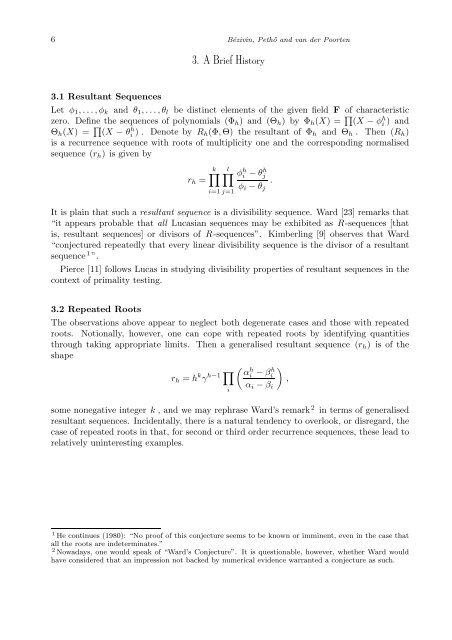A FULL CHARACTERISATION OF DIVISIBILITY SEQUENCES ...
A FULL CHARACTERISATION OF DIVISIBILITY SEQUENCES ...
A FULL CHARACTERISATION OF DIVISIBILITY SEQUENCES ...
You also want an ePaper? Increase the reach of your titles
YUMPU automatically turns print PDFs into web optimized ePapers that Google loves.
6 Bézivin, Pethő and van der Poorten<br />
3. A Brief History<br />
3.1 Resultant Sequences<br />
Let φ1, ...,φk and θ1, ...,θl be distinct elements of the given field F of characteristic<br />
zero. Define the sequences of polynomials (Φh) and (Θh) byΦh(X) = (X − φh i ) and<br />
Θh(X) = (X − θh i ) . Denote by Rh(Φ, Θ) the resultant of Φh and Θh . Then (Rh)<br />
is a recurrence sequence with roots of multiplicity one and the corresponding normalised<br />
sequence (rh) is given by<br />
k l φ<br />
rh =<br />
h i − θh j<br />
.<br />
φi − θj<br />
i=1 j=1<br />
It is plain that such a resultant sequence is a divisibility sequence. Ward [23] remarks that<br />
“it appears probable that all Lucasian sequences may be exhibited as R-sequences [that<br />
is, resultant sequences] or divisors of R-sequences”. Kimberling [9] observes that Ward<br />
“conjectured repeatedly that every linear divisibility sequence is the divisor of a resultant<br />
sequence 1 ”.<br />
Pierce [11] follows Lucas in studying divisibility properties of resultant sequences in the<br />
context of primality testing.<br />
3.2 Repeated Roots<br />
The observations above appear to neglect both degenerate cases and those with repeated<br />
roots. Notionally, however, one can cope with repeated roots by identifying quantities<br />
through taking appropriate limits. Then a generalised resultant sequence (rh) isofthe<br />
shape<br />
rh = h k <br />
h<br />
h−1 αi − β<br />
γ h <br />
i<br />
,<br />
i<br />
αi − βi<br />
some nonegative integer k , and we may rephrase Ward’s remark 2 in terms of generalised<br />
resultant sequences. Incidentally, there is a natural tendency to overlook, or disregard, the<br />
case of repeated roots in that, for second or third order recurrence sequences, these lead to<br />
relatively uninteresting examples.<br />
1 He continues (1980): “No proof of this conjecture seems to be known or imminent, even in the case that<br />
all the roots are indeterminates.”<br />
2 Nowadays, one would speak of “Ward’s Conjecture”. It is questionable, however, whether Ward would<br />
have considered that an impression not backed by numerical evidence warranted a conjecture as such.
















